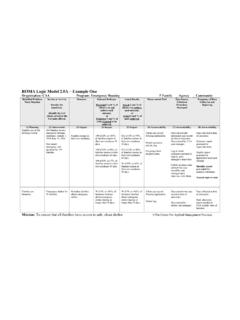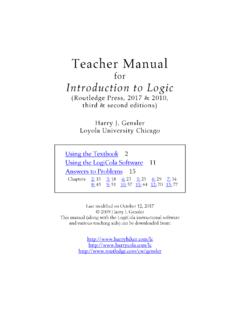Transcription of PROBABILITY THEORY THE LOGIC OF SCIENCE
1 PROBABILITY THEORYTHE LOGIC OF SCIENCEPROBABILITY THEORYTHE LOGIC OF SCIENCEE . T . Jaynesedited byG. Larry Bretthorst Cambridge, New York, Melbourne, Madrid, Cape Town, Singapore, S o PauloCambridge University PressThe Edinburgh Building, Cambridge , United KingdomFirst published in print format ISBN-13 978-0-521-59271-0 hardbackISBN-13 978-0-511-06589-7 eBook (NetLibrary) E. T. Jaynes 20032003 Information on this title: book is in copyright. Subject to statutory exception and to the provision ofrelevant collective licensing agreements, no reproduction of any part may take placewithout the written permission of Cambridge University 0-511-06589-2 eBook (NetLibrary)ISBN-10 0-521-59271-2 hardbackCambridge University Press has no responsibility for the persistence or accuracy of s for external or third-party internet websites referred to in this book, and does notguarantee that any content on such websites is, or will remain, accurate or in the United States by Cambridge University Press, New to the memory ofSir Harold Jeffreys, whosaw the truth and preserved sforewordpagexviiPrefacexixPart IPrinciples and elementary Subjective vs.
2 Objective odel Kolmogorovaxioms (orcomposite) evolutionintoBayesianity? ! , ,ancillarity, likelihood likelihood: way of looking at Significance randomexperiments II Advanced applications11 :Shannon properties of maximum , Objectivity functions and criteria of # ,HaroldJeffreys, ,theprobabilityorthephenomenon? Comparison of Bayesian and cautiousapproach The Hausdorff sphere paradox and s forewordE. T. Jaynes died April 30, 1998. Before his death he asked me to finish and publish hisbook on PROBABILITY THEORY . I struggled with this for some time, because there is no doubt inmy mind that Jaynes wanted this book finished. Unfortunately, most ofthe later chapters,Jaynes intended volume 2 on applications, were either missing or incomplete, and someof the early chapters also had missing pieces.
3 I could have written these latter chapters andfilled in the missing pieces, but if I did so, the work would no longer be Jaynes ; rather, itwould be a Jaynes Bretthorst hybrid with no way to tell which material camefrom whichauthor. In the end, I decided the missing chapters would have to stay missing the workwould remain Jaynes .There were a number of missing pieces of varying length that Jaynes had markedbyinserting the phrase much more coming . I could have left these comments in thetext, but they were ugly and they made the book look very incomplete. Jaynes intendedthis book to serve as both a reference and a text book. Consequently, there are questionboxes (Exercises) scattered throughout most chapters. In the end, I decided to replace the much more coming comments by introducing Editor s Exercises.
4 If you answer thesequestions, you will have filled in the missing wanted to include a series of computer programs that implemented some of thecalculations in the book. I had originally intended to include these programs. But, as timewent on, it became increasingly obvious that many of the programs were not available, andthe ones that were were written in a particularly obscure form ofbasic(it was the programsthat were obscure, not thebasic). Consequently, I removed the references to these programsand, where necessary, inserted a few sentences to direct people to the necessary softwaretools to implement the references were missing and had to be supplied. Usually the informationavailable, a last name and date, was sufficient to find one or more probable references.
5 Whenthere were several good candidates, and I was unable to determine which Jaynes intended, Iincluded multiple references and modified the citation. Sometimes the information was sovague that no good candidates were available. Fortunately, I was able to remove the citationwith no detrimental effect. To enable readers to distinguish between cited works and otherpublished sources, Jaynes original annotated bibliography has been split into two sections:a Reference list and a s forewordFinally, while I am the most obvious person who has worked on getting this book intopublication, I am not the only person to do so. Some of Jaynes closest friends have assistedme in completing this work. These include Tom Grandy, Ray Smith, Tom Loredo, MyronTribus and John Skilling, and I would like to thank them for their assistance.
6 I would alsolike to thank Joe Ackerman for allowing me to take the time necessary to get this Larry BretthorstPrefaceThe following material is addressed to readers who are already familiar with applied math-ematics, at the advanced undergraduate level or preferably higher, and with some field,such as physics, chemistry, biology, geology, medicine, economics, sociology, engineering,operations research, etc., where inference is previous acquaintance with proba-bility and statistics is not necessary; indeed,a certain amount of innocence in this area maybe desirable, because there will be less to are concerned with PROBABILITY THEORY and all of itsconventional mathematics, butnow viewed in a wider context than that of the standard textbooks. Every chapter after thefirst has new ( not previously published) results that we think will be found interestingand useful.
7 Many of our applications lie outside the scope of conventional probabilitytheory as currently taught. But we think that the results will speakfor themselves, and thatsomething like the THEORY expounded here will become the conventional PROBABILITY theoryof the present form of this work is the result of an evolutionary growth over many years. Myinterest in PROBABILITY THEORY was stimulated first by reading the work of Harold Jeffreys(1939) and realizing that his viewpoint makes all the problems of theoretical physics appearin a very different light. But then, in quick succession, discovery of the work of R. T. Cox(1946), Shannon (1948) and P olya (1954) opened up new worlds of thought,whose explo-ration has occupied my mind for some 40 years. In this much larger and permanent worldof rational thinking in general, the current problems of theoretical physics appearedas onlydetails of temporary actual writing started as notes for a series of lectures given at Stanford University in1956, expounding the then new and exciting work of George P olya on Mathematics andPlausible Reasoning.
8 He dissected our intuitive common sense into a set of elementaryqualitative desiderata and showed that mathematicians had been using them all along to1By inference we mean simply: deductive reasoning whenever enough information is at handto permit it; inductive or plausiblereasoning when as is almost invariably the case in real problems the necessary information is not available. But if a problemcan be solved by deductive reasoning, PROBABILITY THEORY is not needed for it; thus our topic is the optimal processing of the early stages of discovery, which necessarily precede the finding of a rigorous results were much like those of James Bernoulli sArt of Conjecture(1713), developedanalytically by Laplace in the late 18th century; but P olya thought the resemblance to beonly , P olya demonstrated this qualitative agreement in such complete, exhaustivedetail as to suggest that there must be more to it.
9 Fortunately, the consistency theorems ofR. T. Cox were enough to clinch matters; when one added P olya s qualitative conditions tothem the result was a proof that, if degrees of plausibility are represented by real numbers,then there is a uniquely determined set of quantitative rules for conducting inference. Thatis, any other rules whose results conflict with them will necessarily violate an elementary and nearly inescapable desideratum of rationality or the final result was just the standard rules of PROBABILITY THEORY , given already byDaniel Bernoulli and Laplace; so why all the fuss? The important new feature was thatthese rules were now seen as uniquelyvalid principles of LOGIC in general, making noreference to chance or random variables ; so their range of application is vastly greaterthan had been supposed in the conventional PROBABILITY THEORY that was developed in theearly 20th century.
10 As a result, the imaginary distinction between PROBABILITY THEORY and statistical inference disappears, and the field achieves not only logical unity and simplicity,but far greater technical power and flexibility in the writer s lectures, the emphasis was therefore on the quantitative formulation ofP olya s viewpoint, so it could be used for general problems of scientific inference, almostall of which arise out of incomplete information rather than randomness . Some personalreminiscences about George P olya and this start of the work are in Chapter the development of applications started, the work of Harold Jeffreys, who hadseen so much of it intuitively and seemed to anticipate every problem I would encounter,became again the central focus of attention. My debt to him is only partially indicated by thededication of this book to his memory.










